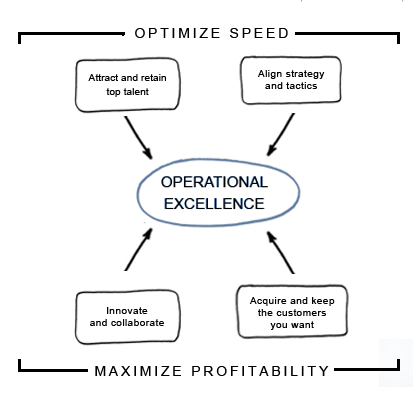5 Critical Components for Redefining Operational Excellence
Operational excellence is a mindset, not a methodology and needs redefining. We tend to think of operational excellence in terms of eliminating waste and standardizing the way we operate. We “lean” our processes and use six sigma approaches to drive how we operate. We also sometimes lean on these methodologies, and others, like crutches to avoid the use of common sense, critical thinking and good judgment. These methodologies protect us from having to make tough decisions or doing what we know is right. They reduce the risk of being wrong, but they also reduce the impact we can have.
The future of operational excellence is not in concepts like cost cutting, waste elimination, standardization, efficiency, and productivity. Those are ways for organizations to survive and restore themselves back to past levels of performance. For those successful organizations that want to thrive and raise the bar to reach new and unheard of levels of performance, you need to focus on concepts like growth, innovation, retention, customization, and boosting performance.
In my book, Redefining Operational Excellence: New Strategies for Maximizing Performance and Profits Across the Organization, I define operational excellence as the constant pursuit of improving performance and profitability in all areas of your organization. It is the ability to find money and performance boosts in areas that others don’t normally look. So what characteristics do excellent companies have that others don’t?
- They perform operational excellence on the front lines, which means employees are empowered to make decisions in the best interest of the customer.
- They align strategy and tactics. They have a clear strategy, they communicate it effectively, and everyone in the organization knows their role in helping to achieve that strategy.
- They practice speed optimization. They know when to speed things up and when to slow things down in order to get the best results.
- They practically apply new ideas. They are able to take the best new ideas and implement them effectively and with the greatest impact.
- They attract and retain the best people.
- They have an action-oriented culture where bureaucracy and risk-aversion are discouraged and productive failure is encouraged.
- They know who their customers are and employ effective strategies to retain them.
- They are able to find money and performance boosts in areas where others don’t normally look.
- They drive innovation and collaboration. They are creative in the development of new ideas and recognize the importance of internal and external collaboration in broadening the impact of those ideas.
- They master profit margin levers. They know when to pull which profit lever in order to maximize results with minimal investment.
These are just a few of the characteristics exhibited by the most successful organizations. How many of these can you comfortably say your organization exhibits?
In order to redefine operational excellence, it means we need to come up with a new definition. Not just about what the term means, but what it’s really all about. This new definition contains five components that we don’t currently associate with operational excellence
1. Driving Innovation and Collaboration
If an organization is not growing, then it is declining. There is no middle ground. There is no status quo. There is no plateau to rest on because everything else around us is changing. In order to grow, organizations need to innovate. That starts by defining what innovation means to an organization – what it is and what it isn’t, why innovation is important, and what impact it can have. What will it help accomplish?
It’s also important to consider how collaboration can help improve results. In many cases, collaborating with other departments within an organization can improve the overall result. It can help develop new ideas faster, develop a more comprehensive solution for the customer, or even reduce the amount of effort required to perform certain activities. Innovation and collaboration are linked.
2. Attracting and Retaining Top People
We often hear how people are the backbone of every organization, which is true. We know it’s important that we have the right people in our organizations, but it’s more important to have them in the right roles employing the right tactics. That starts with the hiring process. The most successful organizations only hire people who are the right fit for the organization and then find the right place for them. That means they come in with the right attitude and the right mindset. They are passionate about the organization and understand the value of working and collaborating with their peers in order to maximize results. By creating the right working environment, and empowering employees to make decisions in the best interests of the customer, you become the organization that people line up to join, not the one they race out the door to leave.
3. Acquiring and Keeping the Customers you Want
The exponential value of customer retention is the easiest way for an organization to ensure consistent growth. This means becoming experts at not only retaining customers, but also growing the size of the business you have with those customers and cultivating them as ambassadors to attract new customers. Once you know your ideal target customer, and you have stratified your customer base to understand who your best customers are, you can develop the right strategies to acquire, keep, and grow business with those best customers.
4. Aligning Strategy and Tactics
Operational excellence can reach all areas of your organization and this can only be accomplished with a clear vision of what you are trying to accomplish as an organization. You need to know what your strategy is and the tactics you need to employ to achieve that strategy. People on the front lines need to see themselves in the strategy and understand how what they are doing is helping the organization to progress towards its’ goals. Think of a champagne pyramid, where you pour champagne into the first glass on the top until all of the lower glasses are full. The champagne cascades down to all levels of the pyramid, just as your strategy should.
5. Optimizing Speed
Although it may sounds counter-intuitive, sometimes organizations need to slow down in order to get better results. The key to optimizing speed is knowing when to speed up and when to slow down in order the achieve the best results. That means having indicators to show your current speed in relation to how fast you could go. You need to consider how fast could you go without sacrificing the quality of what you are doing. Consider a train system where each station is a milestone along the way to a destination. There are indicators all along the route to indicate whether trains should speed up or slow down depending on what’s going on ahead. Do you have indicators that allow you to adjust your organizational speed based on what’s coming up ahead?
 Operational excellence is a mindset, not a methodology. It requires everyone in the organization to come to work looking for ways to improve the performance of the organization. It requires an organization to be able to take good ideas and maximize the benefit from them across the entire organization. It means that the organization can find money and performance boosts in areas that others don’t normally look. It means that each day your organization does things a little bit better than yesterday.
Operational excellence is a mindset, not a methodology. It requires everyone in the organization to come to work looking for ways to improve the performance of the organization. It requires an organization to be able to take good ideas and maximize the benefit from them across the entire organization. It means that the organization can find money and performance boosts in areas that others don’t normally look. It means that each day your organization does things a little bit better than yesterday.
Does this describe your organization? If not, you’ve got some work to do.
By Andrew Miller
 Andrew Miller works with world-class organizations to maximize profitability and performance. As a leading expert in operational excellence, he helps his clients bring together strategies around driving innovation and collaboration, improving customer on boarding and retention, aligning strategy and execution, hiring and retaining top people, and optimizing speed.
Andrew Miller works with world-class organizations to maximize profitability and performance. As a leading expert in operational excellence, he helps his clients bring together strategies around driving innovation and collaboration, improving customer on boarding and retention, aligning strategy and execution, hiring and retaining top people, and optimizing speed.
His clients include McKesson, the Bank of Nova Scotia, 3M, Four Seasons Hotels and Resort, GS1, Mount Sinai Hospital, Agnico Eagle Mines, Women’s College Hospital, the Hospital for Sick Children, and many other world-class institutions. His book, Redefining Operational Excellence: New Strategies for Maximizing Performance and Profits Across the Organization, was recently released by AMACOM.







